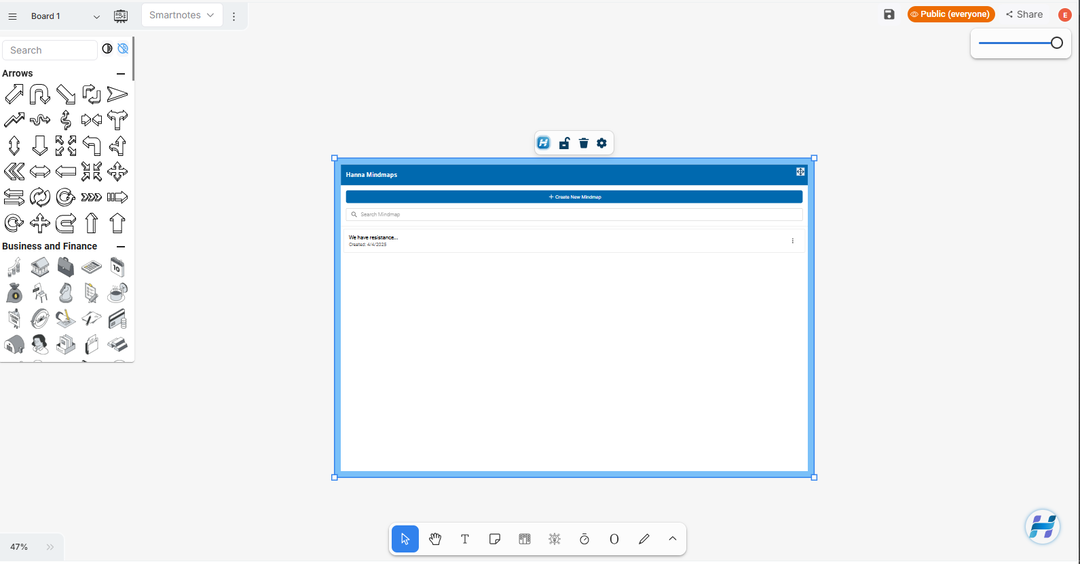Hanna Mindmaps are designed with both personal exploration and collaborative thinking in mind. While mindmaps remain private by default to protect your ideas and information, Hanna offers thoughtful options for sharing when you're ready to bring others into your thinking process.
The simplest approach is to export your mindmap as a *.HM (Hanna Mindmap) file using the settings gear icon. This creates a portable version of your map that can be saved, emailed, or transferred to colleagues. When they open this file in their own Hanna environment, they'll see exactly the map you've created, with all its nodes, connections, and descriptions intact.

For more dynamic collaboration, Hanna offers seamless integration with its Whiteboard feature. When working in a Hanna Whiteboard, you can insert any of your private mindmaps directly into the shared canvas.

This transforms your personal thinking tool into a collaborative asset that team members can view, discuss, and even modify together in real-time. This integration creates a powerful environment where mindmaps become the foundation for deeper discussion and group problem-solving.
Real-time Collaborative Thinking
When a mindmap is shared via Hanna Whiteboard, something remarkable happens. Multiple team members can simultaneously explore and extend the map, creating a truly collaborative thinking environment. One person might be adding detail to the "Risks" section while another explores opportunities, and a third refines the central concept. This parallel processing mirrors how successful teams work through problems together, with each person contributing their expertise to different aspects of the challenge.
The visual nature of the mindmap makes this collaboration particularly effective. Team members can instantly see how their contributions relate to others' work, helping maintain coherence even as the map grows in complexity. The result is a shared understanding that evolves faster and reaches greater depths than would be possible through sequential communication methods like email chains or document comments.
Practical Applications Across Domains
The versatility of Hanna Mindmaps makes them valuable across an impressive range of applications. Strategic planners use them to map competitive landscapes and identify growth opportunities, with the value-framework structure highlighting where to invest resources for maximum impact. Product developers visualize feature sets and potential challenges, creating a comprehensive picture of the development journey ahead.
Researchers find the system invaluable for literature reviews and hypothesis development, with the AI helping identify connections between sources and concepts that might otherwise be missed. Educators use mindmaps to plan curriculum units that capture both the essential content and the relationships between topics, helping students see how individual lessons fit into the bigger picture.
In problem-solving scenarios, teams often start with a situation mindmap to ensure they understand the challenge holistically before moving toward solutions. The "Unexplored" nodes are particularly valuable here, highlighting blind spots that might contain crucial insights. For change management initiatives, the explicit identification of biases helps teams recognize and address resistance factors that might otherwise derail progress.
From Visualization to Action
The ultimate purpose of any thinking tool is to drive effective action. Hanna Mindmaps excel at bridging the gap between abstract thinking and concrete planning through their clear organization and relationship mapping. Many users find that extracting action items becomes intuitive when working from a well-developed mindmap—risks naturally suggest mitigation strategies, opportunities point to initiatives worth pursuing, and unexplored areas highlight where further investigation is needed.
Some teams even structure their mindmaps with implementation in mind, using frames to group elements by time horizon (immediate, near-term, future) or by responsible team. This creates a natural bridge between the conceptual exploration that mindmaps excel at and the practical execution that turns insights into outcomes.
The Future of Collaborative Thinking
As artificial intelligence continues to evolve, tools like Hanna Prodigy AI Mindmaps represent a new paradigm in how we augment human thinking. Rather than simply automating routine tasks, these systems enhance our cognitive capabilities, helping us make connections, identify patterns, and collaborate more effectively. They don't replace human creativity and insight but amplify them, creating a partnership between human and machine intelligence that produces richer, more nuanced understanding than either could achieve alone.
In this way, Hanna Mindmaps offer not just a productivity tool but a glimpse of how AI can help us tackle increasingly complex challenges by enhancing the very ways we think, communicate, and collaborate. The mindmap becomes more than a document—it becomes a shared cognitive space where human creativity and machine intelligence work together to explore, connect, and create meaning.